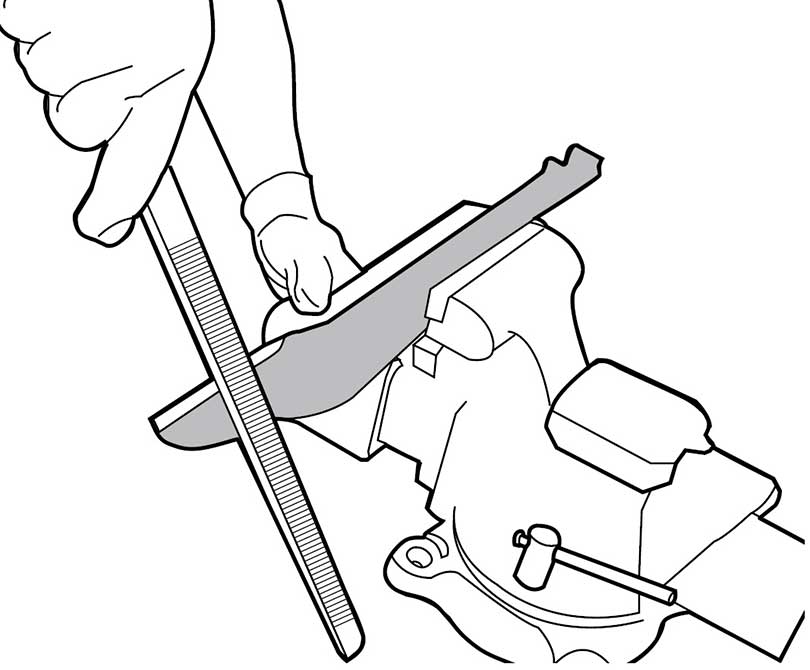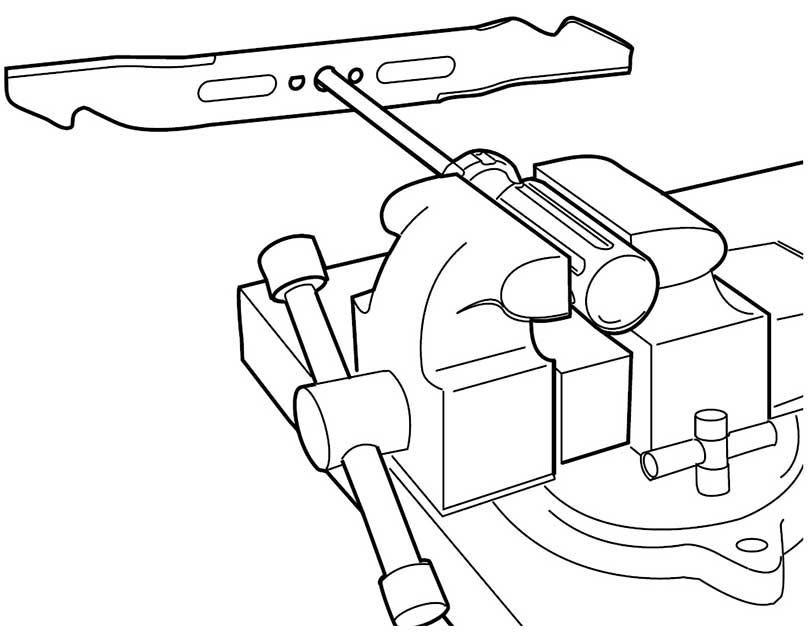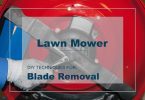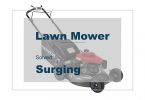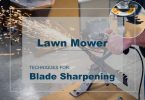Sharpening a lawnmower blade is pretty easy and straight forward, which is particularly true when armed with the right tools.
While homeowners can sharpen their mower blade manually using a basic hand file coupled with a workbench vice, or using power tools which is faster and more efficient as explained below.
Table Of Content
Lift or Tilt Lawn Mower:
Sharpening Tools:
RELATED – Learn how to remove the blade. Also check out this detail guide for sharpening lawn mower blade.
A Mower Lift
When looking to sharpen a mower blade, it is recommended to use a mower lift.
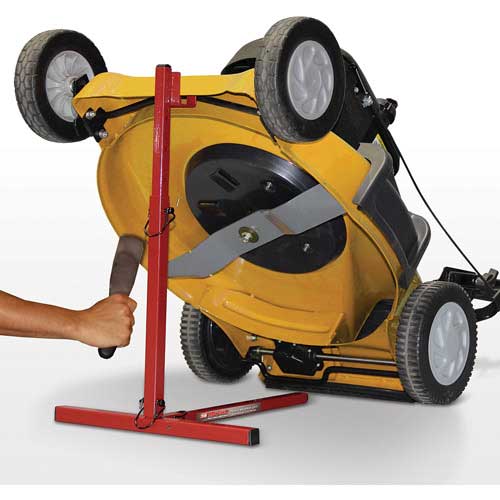
This tool allows to elevate the lawn mower deck to higher elevation, allowing access to the cutting blade safely. For instance, the Mojack Push Mower Lift, 22” boasts a supreme lifting capacity and a clearance of 22 inches. Which allows anyone to remove blade from the machine safely.
This device will not only come in handy when you are looking to sharpen mower blade but also when you are repairing the machine, cleaning it, or executing regular maintenance.
Alternate Solution: Lawn mowers can be tilted side ways without the use of mower lift for removal of the blade, however, it should be made sure that the side with carburetor and air filter is not laying on the ground as the engine oil will leak into the lawn mower carburetor and air filter which will require cleaning. Therefore, tilt the mower to the right side, carburetor side up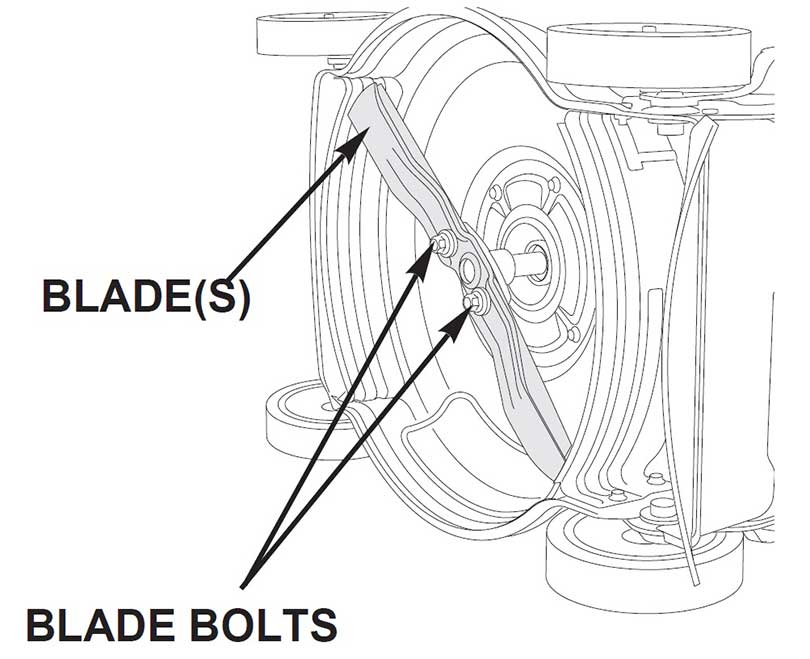
Power Tools
Angle Grinder
As mentioned earlier, getting a clean cut is central to achieving a healthy lawn while reducing the chances of turf diseases and sun damage. This is where angle grinders come in handy; they provide homeowners with an easy and expedient alternative to hand files when it comes to grinding out the nicks and dents on the mower blade, restoring a sharp edge.
Also, unlike bench grinders, angle grinders like Dewalt DWMT70782L Angle Die Grinder eliminate the need to keep holding the mower blade that’s in direct contact with the spinning wheel, ensuring enhance safety for the user.
Air Compressor
To operate an angle grinder, gardeners need to find a reliable source of power. This is where an air compressor comes into play; compressed air is among the most useful and versatile forms of energy available today. Unlike electric devices, an air compressor allows more convenient usage, and it can power multiple pneumatic tools at once. For instance, Bostitch BTFP02012 6 Gallon, 6 gal is not only sufficiently powerful to run several angle grinders, but it’s also impressively quiet.
Couplers and Plugs
When using an air-powered angle grinder, it’s imperative to ensure that the compressed air system is delivering an adequate volume of air while also maintaining the appropriate pressure. Maintaining an efficient air system capable of delivering optimal abrasive performance is dependent on a few factors. Such include the size or horsepower of the compressor, the capacity of the receiver tank, as well as type of plug/coupler. With the right plug and coupler kit, maintaining an airtight connection for the air compressor becomes easy.
Disc Pad Holder
Pad holders are used for mounting the angle grinder’s discs, improving the grinding and cutting performance the appliance. These holders facilitate easy and expedient disc attachment, removal, and reattachment during grinding and sanding projects. For example, the ProTool 5542 Roloc Disc Pad Holder Shank, 2″ L allows the angle grinder’s efficiency for easy sharpening and polishing of the lawn mower blades.
The Angle Grinder Discs
The angle grinder disc is tasked with grinding, sharpening and polishing cutting surfaces, including those of a lawnmower. Basically, these are round, thin, and flat panels that are substantially similar to CDs or DVDs. There are different discs for diverse cutting jobs, which include grit discs, diamond discs, and wood discs. It’s, therefore, imperative for users to consider the chore in hand and the associated materials to make a suitable purchase.
Vice
Vice is used to hold the blade in place during sharpening, instead of Vice, c-clamp can also be used which would be a cheaper alternative.
Blade Balancer
The primary purpose of a blade balancer is to ensure that the lawn mower blade is sharpened evenly while also reducing engine wear. This, in turn, extends the usable life of the machine. By reducing the mower’s vibrations during sharpening, the angle grinder’s user gets to achieve a smoother cut. A balanced blade also goes a long way in reducing the operator’s fatigue that’s otherwise caused by vibrations.
Manual Tools
Lawnmower blade can be definitely sharpen but depending on the wear, it may take longer and it is a cheaper alternative to using the power tools.
Tools Required:
- Vice or C-Clamp
- Mill bastard file
- Screw Driver
Steps:
- Once the blade is removed, mount it on the vice making sure the area that requires sharpening is facing upwards.
- Start sharpening with mill bastard file by running it back and forth against the blade as shown in the picture below.

- Remove the blade and mount the screw driver on the vice and hang the blade to make sure it is leveled on both sides. If one sides looks heavier, remove more iron by continuing to file that side.

- Once completed, remount the blade and take the lawn mower for test run.
For both sharpening tools it is best to remove the blade from the lawn mower deck however, if you wish to sharpen the blade without removing it the manual tools can be used however it is bit difficult to sharpen the blade without removing it.
A dull mower blade often means that the grass will be ripped as opposed to getting cut with precision. This might cause root damage, poor regrowth, not to mention a patchy and unsightly lawn.
To get the best experience sharpening their lawn mower blades, every gardener needs to invest in appropriate tools for the job, including mower lifts, air compressor, and disc pad holders to mention a few.

